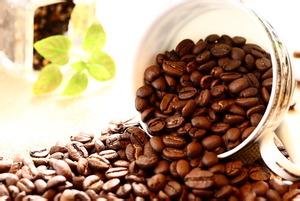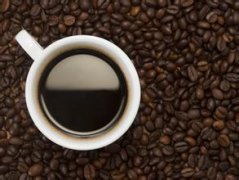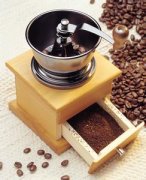Explanation on the baking stage of coffee beans
Coffee roasting is a high-temperature coking dye (Pyrolysis), which changes the substance inside the raw bean, produces new compounds, and combines to form a fragrance and mellow flavor. This kind of impregnation will only occur at high temperature, and if you only use low temperature, it will not cause differentiation, no matter how long the roasted coffee beans will not be cooked.
Most people think that baking is nothing, just stir-fry the raw beans over fire. In fact, in the coffee processing process, baking is the most difficult model, it is a kind of science, but also an art. In the West, experienced bakers enjoy a highly respected position.

Baking can be divided into three stages:
Drying
High temperature differentiation
In the early stage of baking, raw beans begin to absorb heat, and the internal water gradually evaporates. At this time, the color gradually fades from turquoise to yellow or light brown, the silver film begins to fall off, and a faint smell of grass can be smelled. The primary impregnation at this stage is the removal of moisture, which accounts for about half of the baking time. Because water is a good thermal conductor, it helps to bake the internal substance of coffee beans. Therefore, although the aim is to remove water, the baker will make good use of the temperature of the water and control it properly so that it will not evaporate too fast. it is best to control the water to reach the boiling point in ten minutes, when the internal material is full and hot, and the water begins to evaporate and spill over to the outside of the coffee beans.
Baked to 160 degrees Celsius, the water in the beans will evaporate into gas. At this time, the interior of raw beans changed from endothermic (Endothermic) to exothermic (Exdothermic) showing the first burst sound (Crack). After the bursting sound, it turns to endothermic, at this time, the pressure inside the coffee bean is very high, which can reach 25 atmospheric pressure. High temperature and pressure begin to deconstruct the original tissue to form new compounds, resulting in the taste and taste of coffee; at about 190 degrees Celsius, the transition between endothermic and exothermic occurs again. High temperature pyrolysis and dyeing continued to occur, and the coffee beans changed from brown to dark brown.
Cooling
After the coffee is roasted, it must be cooled immediately to quickly curb the high temperature cracking and impregnation, and lock the flavor. Otherwise, the high temperature in the beans will continue to occur and the fragrant substances will be burned away. There are two ways of cooling: air-cooled and water-cooled. Air cooling is the rapid cooling of coffee beans with a large amount of cold air in three to five minutes. In the professional baking scale, large roasters are equipped with a tray with a reversable urging arm; when the baking is completed, the beans are automatically fed into the tray, and the fan at the bottom of the tray is started immediately to blow cool air. And the urging arm stirs the coffee beans to cool them. Although the air-cooled type is slow, it is clean and non-polluting, and can better retain the fragrance of coffee, so it is used by those who specialize in selected coffee. The water-cooled type is to spray a layer of water mist on the profile of the coffee beans, causing the temperature to drop rapidly. Because the amount of water sprayed is very important, it requires careful calculation and control, and it will increase the weight of baked beans, which is generally used for large commercial baking.
The roasting level of coffee beans can be divided into six categories
Light baking (LightRoasts), cinnamon (Cinnamon), half-city style (HalfCity), New England style (NewEngland). This kind of baking is only used for absolutely high-quality Arabica coffee beans grown in dense or highland areas, mainly for the cutting and tasting of coffee beans, and generally not on products sold in the market. Cinnamon, so called because its roasted color is very similar to cinnamon, this roasted coffee beans are very acidic, but very mellow.
Light to moderate baking (MediumLightRoasts), there are mild American style (LightAmerican), light style (LightCity), West Coast style (WestCoast).
Medium baking (MediumRoasts), including American baking (American), breakfast baking (Breakfast), brown baking (Brown). American baking is also called "normal" or "brown". When the table is made without oil, the color will be very dark and is generally used in the roasting of dripping coffee.
Medium and deep baking (Medium-DarktoDarkRoasts), citywide baking (FullCity), mild baking (LightFrench), Viennese baking (Viennese). Viennese, which means slightly darker than medium baking. This kind of baking comes with dark brown black spots and a little oil on the profile.
Deep baking (Dark/HighRoasts), including after-dinner style (AferDinner), continental style (Continental), European style (European), French style (French), Italian style (Italian), New Orleans style (NewOrleans). Continental style can also be called "double roasting" and "high". This roasted coffee beans have a chocolate-like color and are described as "very deep" and "very important" roasting; Italian style, it is mainly used in the roasting of Italian coffee beans. In the United States, this roasting is darker in color, sometimes called "concentrated" roasting, and the roasted coffee beans are almost black and very oily, and its primary taste comes from the roasted taste rather than coffee.
Very deep baking (VeryDarkRoasts), there are deep French (DarkFrench), carbon (Charcoal), in which carbon is rarely used. (the origin of carbonated coffee Japan is a country that does not produce coffee and is late in taking over coffee. If the Japanese want to make coffee with their own characteristics, they roast coffee beans to a very deep level, similar to carbon, named charcoal.)
Important Notice :
前街咖啡 FrontStreet Coffee has moved to new addredd:
FrontStreet Coffee Address: 315,Donghua East Road,GuangZhou
Tel:020 38364473
- Prev

Coffee roasting CoffeeRoasting
Coffee is loved mainly because of the fragrance formed after roasting and the taste of drinking. The coffee raw bean itself does not have any special taste, it is roasted to completely change and reorganize the substances inside the raw bean to form a new structure, bringing out the mellow flavor of the coffee.
- Next

Explain the roasting degree of four coffees
CinnamonRoast: cinnamon baking: this is the lightest kind of baking. There is no oil on the surface of the coffee beans. Large coffee bean manufacturers often mix the lightly roasted coffee beans with the coffee beans they sell. Because doing so can save money and increase the amount. Coffee beans baked with cinnamon usually don't look like CityRoast baked in the city at the moment.
Related
- What is the meaning of lactic acid fermentation with coffee bean treatment?
- How to judge the state of foam by sound?
- How does the latte pull out the unicorn pattern? Come to get for a little trick to improve the flower pull!
- Will flower pulling affect the taste of the latte?
- Do you know the history of coffee?
- The difference between honey treatment and sun washing what is raisin honey treatment?
- What kind of milk can a novice use to make coffee foam to keep the foam longer? The correct method and skills of milking tutorial sharing
- Why do washed coffee beans taste sour? Flavor characteristics of washed Coffee
- Introduction to the skill of how to practice the size and height of water injection around the circle of hand-brewed coffee
- How do beginners practice coffee flower drawing from scratch?

